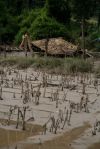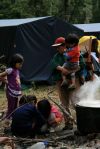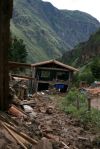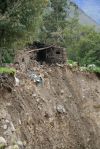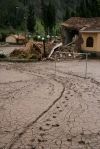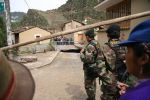Okay, so the Inti Raymi drama and dancers were cool, festival of Chokakillka out of this world, and random days off from school much appreciated. But my new favorite holiday is the Third of July.
Because the people of Ollantaytambo aren´t too concerned with some stupid American holiday, there were unavoidable conflicts tomorrow and we decided the Declaration of Independence could have just as easily been signed on the third and threw a party tonight.
It´s weird, having been in Peru for about five weeks now, what reminds you of America. We made a wish list of things that would make our fiesta legitimate, and people tried their best to make it happen here.
Some ideas turned out better than others. The marshmallows for s´mores from Urubumba were tough in a way marshmallows just should not be, the cheese was not cheddar, and instead of apple pie there was apple crumble. There were no pickles to be found.
But overall it was a success, and the Peruvian influence wasn´t all for the worse. There was an obscene amount of guacamole, and no shortage of potatoes or corn. There were more woven scarves than patriotic attire, and while there wasn´t a single American flag in sight, there was red and blue jello. People had to improvise.
There were real hamburgers with buns, watermelon, potato salad, coleslaw, and s´mores roasted over an oil drum. There were even hushpuppies, courtesy of Jacob, who did the South proud with his cooking.
There was non-Peruvian music coming through the speakers, and we sat in the concrete courtyard as though on a picnic. Someone drew a Twister board on pieces of paper and I called out ¨red food on blue¨to my heart´s content. We set off ¨fireworks,¨otherwise known as gunpowder tied to a broomstick, in a cornfield outside Ollanta, and someone put the Star-Spangled Banner on repeat on iPod speakers.
Toasting the United States against the backdrop of the Andes in the moonlight, it was a salute to our beloved home country and what it represents, as well as an appreciation for everything Peru and its people have given us.
God knows our country isn´t perfect, but I´ve come to realize that for the most part, we have it pretty good in America. The average American child has far more opportunities avaiting him than the average Peruvian does, although these advantages do come with responsibilities. To global awareness, cultural understanding, and some degree of humility, for starters.
I´m starting to think that you have to leave the United States to begin to understand what it means to be American.
I was 10,000 miles from the nation´s capital, but toniight´s celebration in a cornfield in Peru was the most fitting tribute to our independence that I could imagine. Even if it was a day early. So happy Third of July, everyone. Tomorrow you better appreciate your civil liberties and cheddar cheese.
Read Full Post »
